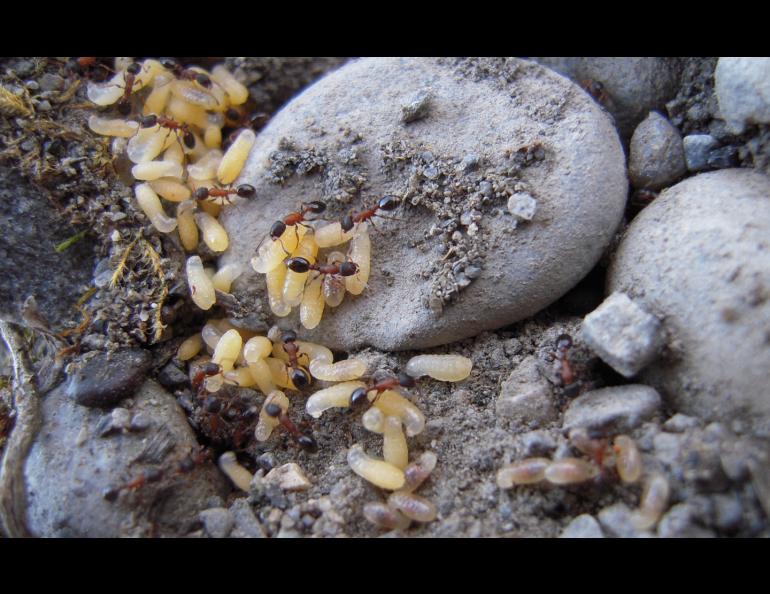

Buzzing with activity while the sun shines
As Alaska cools and hardens, many scientists are reacquainting themselves with their offices. Such is the case for Derek Sikes, the curator of insects at the University of Alaska Museum of the North. This summer, he traveled across Alaska, from Sagwon Bluffs to Sitka and many places between, including a trip to the Aleutians for good lateral coverage.
Sikes’ tales of his recent insect explorations in Alaska have a Lewis and Clark feel. Scientists have inventoried the insects of Alaska for a long time, but those men and women were very few compared to the researchers studying caribou or the aurora. Because of this dearth of people looking for bugs, Alaska’s rock crevices and tidal splash zones still hide plenty of undiscovered species. Sikes and his colleagues have added more than 1,000 to the Alaska list of insects (and have collected 20 that are new to science) since he moved northward and started work at the museum four years ago. During the short period when insects are crawling, flying and hopping, he jumps at every opportunity to find more.
Sikes’ summer of 2011 began with an ant road trip. His friend, North Carolina State University biology professor and natural history book author Rob Dunn, sponsored a trip around the state to duplicate an expedition an ant researcher made around in Alaska 30 years ago.
Sikes was out to sample the state of the state’s ants in 2011. In following the path driven by the ant collector three decades ago, Sikes ventured about as far north as he could, bumping along the Dalton Highway to Sagwon Bluffs, about 60 miles shy of the Arctic Ocean. He found no ants there, but after flipping about 200 rocks at Happy Valley camp a few miles farther south, he found a nest wriggling with activity, and then another. He uncovered more ant nests beneath south-facing rocks near Toolik Lake. With help from ant-seeking volunteers who work at the UA Museum, Sikes was able to find about 30 species as he duplicated the travels of the biologist of the 1980s, from Sagwon Bluffs down to the Kenai Peninsula.
“We found ants everywhere he found them,” Sikes said. “We want to know if any species are extending their ranges northward.”
As with all his summer insect gatherings, Sikes and the people in his lab won’t know what they’ve found until they sit down and sort out the tiny bodies carried back to Fairbanks.
Not long after the ant road trip, Sikes caught a plane for Adak and then boarded a ship to Kasatochi, in the middle of the Aleutian Islands.
Kasatochi blew up in 2008, morphing from a green seabird paradise to a gray pile of mud and ash. Sikes had the good fortune of spending a day on the island on year before it erupted, and he has returned the three summers since to observe how insects repopulate an earthen moonscape.
During three days on the donut-shaped island with a crater at its center, Sikes found and collected 25 species of insects, up from 18 the year before. He discovered lots of midges that eat algae and a predatory fly that is now near the top of the Kasatochi food chain. He also carried home a sample of plant roots and stems that the eruption buried three years ago. At home, he stuffed the vegetation in a Berlese funnel, a device that uses heat to drive living things out of soil and plant matter. He was expecting nothing, but witnessed the emergence of two springtails and a mite. Sikes was shocked.
He still questions whether the tiny creatures survived the eruption and three years without food, water or oxygen.
“It’s one of those extraordinary discoveries that requires extraordinary evidence,” he said. “But, then, springtails are some of the most indestructible creatures on Earth. They can be frozen, and they can live through dehydration. They are the ones who would survive something like this.”
From the Aleutian Islands (which, as far as anyone knows, do not host a single ant), Sikes made a few trips to Southeast Alaska. One was to the high country of Dall Island, where he found Alaska’s first example of a primeval wingless insect known as a Dipluran. After that, he traveled to Sitka for a conference and beachcombed for intertidal insects in his down time.
Down time is something Sikes now has, since Alaska’s insects are either frozen or are employing their own antifreeze or freeze-tolerant strategies to bide their time. They wait in silence until the sun will once again circle the northern horizon. Then, when the soft tundra is humming with wingbeats, Derek Sikes will again be on his knees, turning over rocks somewhere in the wilds of Alaska.






